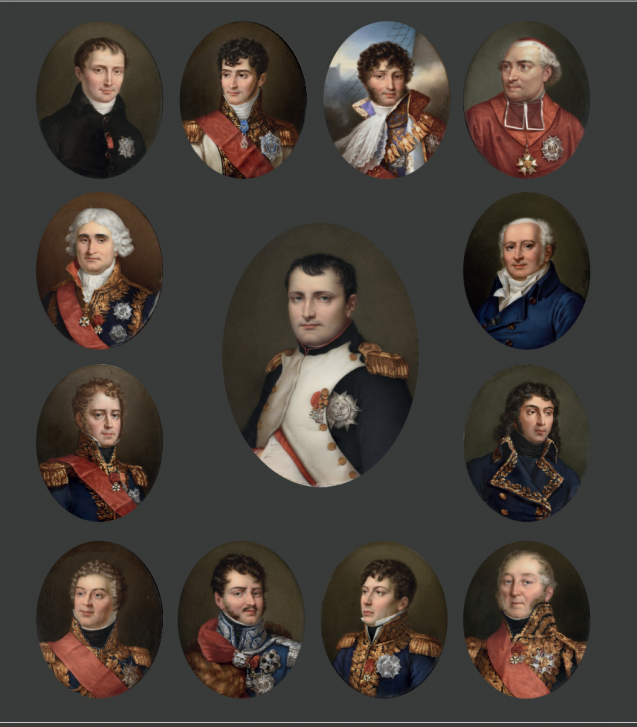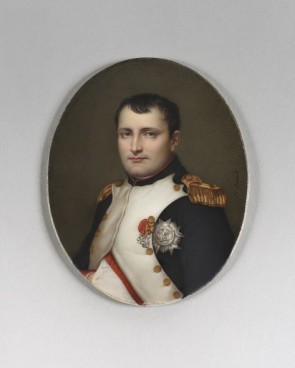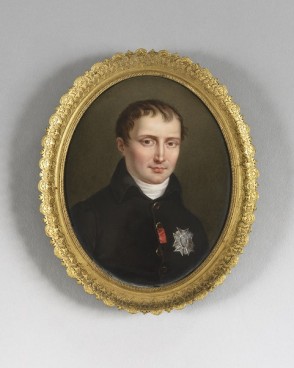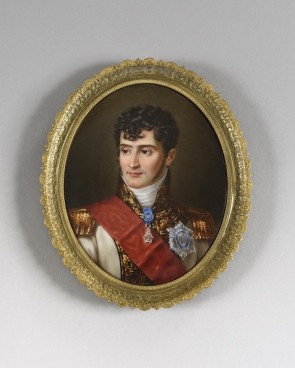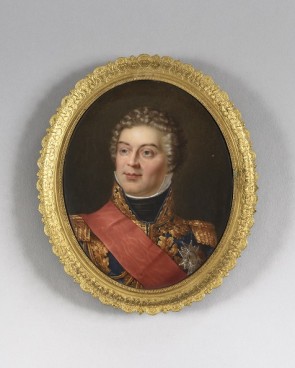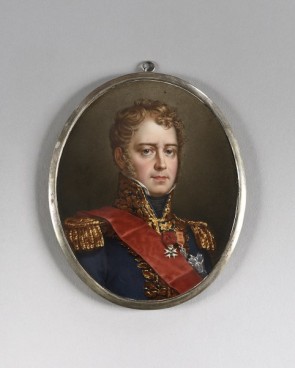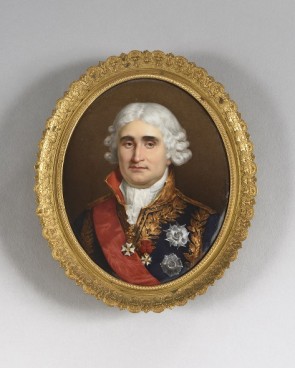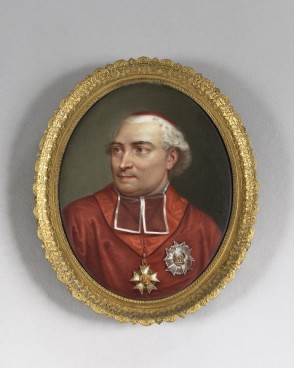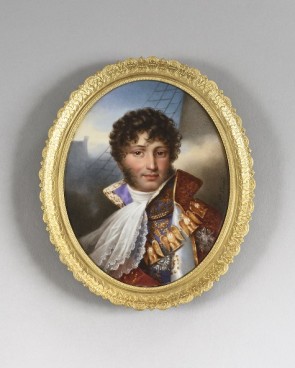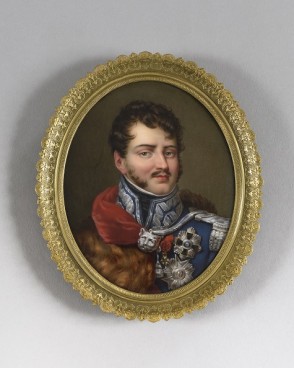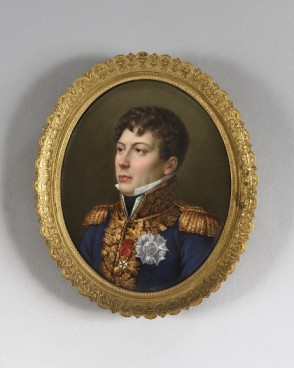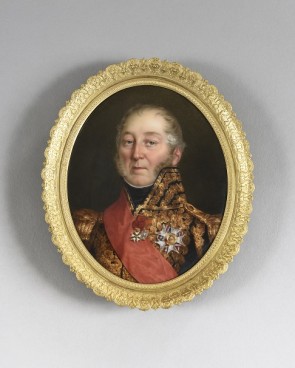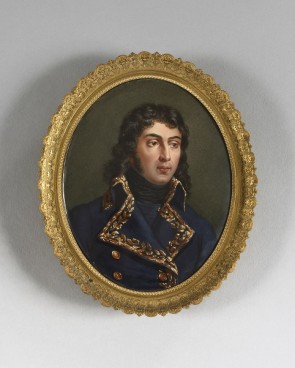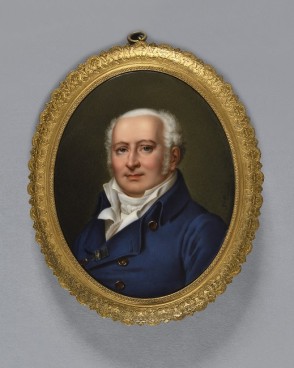A painter in miniature
From the First Empire there was a great enthusiasm for painting on ceramics, right up until the advent of colour photography. Oil paintings tended to yellow or collect dust, depending on the varnish used by the artist. In order to restore the true colours of the works, it was not uncommon to see certain artists ‘borrowing and copying’ great masters’ paintings and transposing them onto another medium namely porcelain. The study of pigments and the successive firings of colours enable the original appearance of the works to be preserved. Porcelain has the advantage of being unalterable.
A number of women achieved fame thanks to this speciality. The best known is undoubtedly Marie-Victoire Jaquotot. The Fondation Napoléon owns a portrait of Napoleon in his coronation robes. Her reputaiton was such she was allowed to borrow paintings from the Louvre for several weeks at a time. Sophie Liénard was another artist who worked on porcelain. As noted in the Almanach général de la France et de l’étranger for 1839, she was self-employed and did not join the Sèvres factory, but worked with the Rihouet earthenware workshop.
Sophie Liénard
It’s hardly surprising that Sophie Liénard became interested in porcelain painting. A number of people in her entourage led her to this profession. First of all, her grandfather was a merchant who trade included selling boxes featuring miniatures. It is highly likely that Sophie developed a taste for this type of art from an early age. She began painting on porcelain in the 1820s, signing under her maiden name Sophie Girard.
In 1831, she married Justin Liénard, also a “figure painter” for the Sèvres factory. He was probably one of Marie-Victoire Jaquotot’s pupils; it is possible that his wife also studied with her. Her work enabled Sophie Liénard to exhibit at the Salon from 1842 to 1847, giving her a certain notoriety and access to the court of Louis-Philippe and then Napoleon III. The work of the husband and wife is quite similar, sometimes difficult to distinguish from one another. However their signatures make it easy to identify their work: Sophie Liénard always signed with her first name, whereas Justin only affixed his initial to his name. Her portraits have a lightness that allows a glaze to be applied to the colours she uses, so that the figures appear with a characteristic purity.
A new addition to the Fondation Napoléon collection
This series of miniatures was certainly commissioned by Louis-Philippe. They were painted in the 1840s, and represent members of Napoleon’s family and the great dignitaries of his court. Their production corresponds to the period of the creation and opening of the Musée de l’Histoire de France (Museum of the History of France) in 1837. Located in one of the wings of the Château de Versailles, it was dedicated to “all the glories of France”. The July Monarchy commissioned a large number of works, particularly paintings of France’s great battles, from the great artists of the time to decorate the display areas. The museum was intended to be as exhaustive as possible in its coverage of the history of France and represent the different political regimes, featuring military events from the Middle Ages, such as the Battle of Bouvines (1214), to the Battle of Austerlitz (1805).
It is therefore quite likely that the commission made to Sophie Liénard represents a desire to create effigies of the various important figures who marked the turn of the 19th century. It should also be noted that in 1840, Louis-Philippe’s ambition to bring back Napoleon’s mortal remains form St Helena (known as the Retour des Cendres) revived an interest in the history of the First Empire. Unfortunately, it is not possible to confirm for certain that this commission came from the July Monarchy, or to determine the number of portraits commissioned. However, given the significant number already identified (nearly twenty), it is certain that this commission came from a person close to the reigning authorities.
Although these works date from slightly later than the period to which our Fondation is consecrated, this collection of thirteen miniatures on ceramics has the advantage of presenting a portrait of many key figures from the First Empire. Each is based on a major painting by a master of the early 19th century. The portrait of Napoleon is after one by Jacques-Louis David, while the portrait of Corvisart is a copy of one by Baron Gérard. Sophie Liénard also seems to have been inspired by François-Séraphin Delpech’s Album lithographique ou recueil de dessins sur pierre, par des artistes français, published in 1819. Indeed, several portraits from that publication can be identified, including that of Duroc and Cambacérès.
Description of the personalities
Of the thirteen miniatures, one depicts Napoleon I, and four others are portraits of members of the imperial family: his eldest brother, Joseph Bonaparte; the youngest brother, Jérôme Bonaparte; Joachim Murat (Caroline Bonparte’s husband); and Cardinal Joseph Fesch, the Emperor’s uncle. The nine other portraits are of dignitaries of the Empire. They include five marshals: Michel Ney, Louis-Alexandre Berthier, Joseph-Antoine Poniatowski, Michel Duroc and Édouard Mortier. The last three miniatures are of Jean-Nicolas Corvisart (Napoleon I’s physician); Louis-Charles-Antoine Desaix, dressed as a Revolutionary general who distinguished himself in the Egyptian and Italian campaigns; and Jean-Jacques Régis de Cambacérès, Archchancellor of the Empire. All the portraits feature Empire decorations. The artist has endeavoured to depict as many details as possible so that they appear as realistic as possible. With the exception of the portrait of Joachim Murat, the backgrounds of the miniatures are dark and neutral, which serves to highlight the freshness of the colours used for the figures. Perhaps the most noteworthy are the portraits of Jérôme Bonaparte, Michel Ney and Joseph-Antoine Poniatowski: the different decorations, the lavishness of the uniforms and the way the light falls on the faces immerse us in the atmosphere of the court of the First Empire.
This series of portraits, by Sophie Liénard, are of identical shape and size; they bring a certain coherence to the Fondation Napoléon’s collection, constituting an important ensemble on a par with Martial Lapeyre’s acquisition policy (for example, the dishes known as “Quartiers Généraux” or, more recently, the set of images from Epinal). In addition, the Fondation Napoléon collection already possesses a portrait by Sophie Liénard: it is a portrait of François-Joseph Talma in the role of Nero (INV 657). Its size and the decoration of the gilded bronze frame allow us to confirm that it is from the same series as the thirteen portraits acquired in 2021.
Take a look at the portrait gallery:
Élodie Lefort (translation RY)
February 2022
Élodie Lefort is responsable for the Fondation Napoléon collection.


